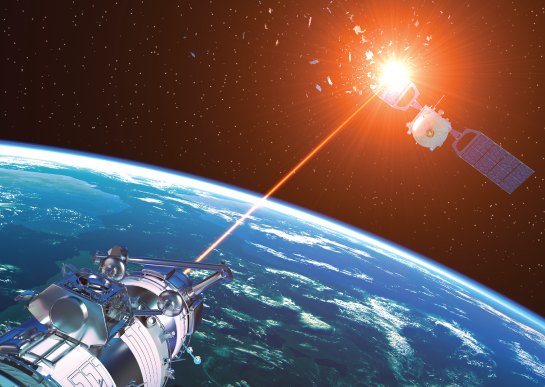Defense S&T Spotlight
April 2025
Defense S&T Spotlight compiles news and updates relevant to DoD and the research and engineering (R&E) community and highlights DTIC resources that will empower you to better analyze, shape, and share your science and technology efforts.
Spotlight Areas
- R&E In The News
- DTIC Products & Services
- DoDIAC
- Quarterly Features
- News Center
- Defense S&T Spotlight - January 2025
Remember, credentials control the type of information accessible to users.

DTIC continues to innovate offering depth and breadth to the knowledge we provide our stakeholders. We ensure the innovation and knowledge stemming from DoD's past and current investment in science and technology forms the building blocks for the next generation of discovery and accelerates capability to the warfighter.
R&E In The News
President Trump sent a letter to Mr. Michael Kratsios, director of the White House Office of Science and Technology Policy, highlighting the importance of scientific progress and technological innovation as key drivers of the American century.
In the letter, the president reflects on significant achievements such as the Manhattan Project, the Apollo Program, and the development of the internet, noting that these successes were not accidental. He emphasizes that it is crucial for America to reclaim its position as the world's leader in technology and innovation.
President Trump assigns Mr. Kratsios three "How Can We" challenges:
- Securing Technological Leadership: President Trump emphasizes the need for the U.S. to maintain its dominance in critical and emerging technologies, (e.g., artificial intelligence, quantum physics, nuclear technology). This requires, he writes, accelerating research, removing regulatory barriers, and promoting domestic manufacturing along with private-sector investment, which are essential steps to preserve our advantage over potential adversaries.
- Revitalizing Science and Technology Enterprise: President Trump states it's essential to reduce administrative burdens on researchers to achieve groundbreaking discoveries. Additionally, he writes, we must develop new funding models and create a supportive ecosystem that attracts top talent, allowing scientists to concentrate on meaningful work.
- Driving Economic Growth with Scientific Progress and Innovations: President Trump notes scientific advancements should improve the lives of all Americans. Previous initiatives, such as the American Artificial Intelligence Initiative, the National Quantum Initiative, and the Space Force, have strengthened America’s technological supremacy. “We must set our sights even higher.”
“We have the opportunity to cement America’s global technological leadership and usher in the Golden Age of American Innovation. We are not just competing with other nations; we are seeking, striving, fighting to make America greater than ever before,” Trump wrote.
Explore relevant S&T reports related to this article here.
Source: The White House

Defense Secretary Pete Hegseth emphasized the vital roles of the Air Force and Space Force in future military conflicts during the Department of the Air Force Summit at Joint Base Andrews, in March.
He stated the effectiveness of these branches in projecting airpower will significantly influence U.S. deterrence against peer adversaries, especially China. Hegseth underscored the importance of the space domain in modern warfare and predicted an increase in investments in both offensive and defensive capabilities in that area.
He also highlighted that strategic capabilities in space could change the outcomes of conflicts.
Regarding budget realignment with national security priorities, he acknowledged the focus on efficiency and spending. However, he reaffirmed commitments to rebuilding the military, with the Air Force playing a central role in funding.
Explore more relevant reports here.
Source: U.S Department of Defense

The Defense Information Systems Agency (DISA) is planning to introduce a platform at the U.S. Indo-Pacific Command (INDOPACOM) in the next few months. This platform will let users test a generative artificial intelligence (AI) tool on classified networks.
Jeff Marshall, acting director of DISA's Hosting and Compute Center, reported that the chatbot will be available on the Secure Internet Protocol Router (SIPRNet) after it gets accreditation, which should happen this spring.
DISA created this initiative with the help of the Air Force Research Lab (AFRL), which recently released an unclassified generative AI chatbot called NIPRGPT, available on DoDNetworks. DISA wants to test commercial AI tools in classified settings.
Jeff Marshall stressed this is a research and development project, not a full production system. The focus is on understanding what INDOPACOM commanders need from AI. The SIPR-based large language model will help identify these needs and show how the industry can meet them.
Explore more relevant reports here.
Source: DefenseScoop

The U.S. Army is working to enhance autonomy in its Golden Dome missile defense architecture through artificial intelligence.
At the Association of the U.S. Army’s Global Force Symposium, Maj. Gen. Frank Lozano outlined plans to integrate AI-enabled fire control systems, create remotely operated units, and develop fully autonomous systems to reduce the need for manpower.
The Army's contributions to the Guam Defense System, which is expected to become operational by 2027, will help inform the adaptation of the Golden Dome. Key developments include containerized missiles and reduced maintenance requirements.
The Army plans to refine the roles of human operators within integrated fire control systems and collaborate with new market entrants, such as firms like Safran and Anduril, to incorporate advanced AI capabilities. In the coming months, the Army will define its requirements and begin discussions with industry partners.
Explore more relevant reports here.
Source: Defense News

The Full-Year Continuing Appropriations and Extensions Act of 2025, signed into law on March 15, set spending levels for Pentagon research, development, test and evaluation (RDT&E) accounts through the end of September. RDT&E funding is set at $141 billion, approximately 15% of the $892.5 billion budget for the DoD.
The Army’s share of the RDT&E funding is around $14 billion, the Navy’s is $26 billion, the Air Force’s is $46.8 billion and the Space Force’s is $18.6 billion.
Defense-wide RDT&E accounts will get $35 billion, and nearly $350 million will go toward operational test and evaluation. Overall, RDT&E spending levels are $7 billion less than the DoD received in FY24.
Delve deeper into RDT&E appropriations with Horizons.
Source: DefenseScoop
DTIC Products & Services

Use your DoD-issued CAC, PIV, or ECA to access DTIC’s R&E Gateway and its extensive collection of controlled-unclassified DoD technical reports and research projects.
Need help signing in or registering? Email DTIC or call 800-225-3842.
DTIC DoDTechipedia users now have an easy and convenient way to search recently added technical reports.
A new page on DTIC’s collaboration tool, produced by DTIC’s research librarians, categorizes reports by:
- Critical Technology Areas. 14 critical technology areas DoD says are vital to maintain national security
- Communities of Interest. Multi-agency collaboration across 16 interest areas in cutting-edge technology
- DTIC Thesaurus Subject Categories. 25 subject categories of interest ranging from agriculture to space technology.
The innovative work of the research community on warfighting solutions relies on credible, DoD-funded research results that can be reused to further scientific progress. DTIC collects, organizes, and safeguards the outcomes of the DoD's multibillion-dollar annual investment in science and technology information. As the DoD's designated agent for collecting funded research, DTIC serves as a secondary disseminator of technical reports under DoD Directive 3200.12. This directive mandates that all funded DoD research, whether conducted in-house or by contractors and grantees, be submitted to the DTIC collection.
Submissions provide several benefits to the Science and Technology (S&T) community:
- Maximizing Research & Development (R&D) dollars and reducing duplication of efforts
- Accelerating development of new capabilities and technical solutions for our warfighters
- Ensuring long-term availability and preservation of documents
- Leveraging results from defense-funded research
- Increasing peer citations and the dissemination of research within the S&T community
We encourage everyone involved in research, development, testing, and evaluation (RDT&E) to ensure that DoD-funded research is submitted to DTIC. Submit your DoD scientific and technical information to DTIC's collections today.
DTIC is in the process of finalizing the launch of a highly anticipated feature: bulk uploads via DTIC Submit portal. This new capability, developed in response to user feedback, will facilitate quicker and more efficient submissions of scientific and technical information.
Within the third quarter of FY 2025, the DTIC-Submit portal will introduce a bulk upload capability simplifying how DoD organizations contribute technical reports, journal articles, conference proceedings, and other scientific and technical documents to the collection.
Bulk uploading promises to reduce friction in meeting submission requirements, especially for programs with large volumes of content or internal repositories.
Bulk uploads will offer two submission paths:
- A system-to-system API for automated, ongoing transfers
- A structured file upload option using XML, JSON, or CSV formats
Both methods will support validation, tagging, and accessioning at scale to streamline intake without sacrificing data quality.
DTIC is actively engaging early adopters to ensure integration paths are flexible and effective. Organizations interested in participating or preparing for implementation are encouraged to reach out now.
Why This Matters
✔️ Supports submission of all DoD-funded scientific and technical information, including:
- Technical reports
- Journal articles
- Conference proceedings
- Final performance reports
✔️ Helps meet the requirements of DoD Directive 3200.12
✔️ Enables better access, reuse, and preservation of research outputs
✔️ Designed to integrate with internal content management workflows
DTIC’s Horizons application recently added a new feature allowing users to save results from their search queries. This time-saving feature allows you to create a personalized list of records for future reference organized in personalized folders for future access.
Additional updates:
- New Data Available and More Comprehensive Data: DTIC recently upgraded its Technical Reports submission capability. Horizons users can access this expanded collection of reports, leading to more discoverable research opportunities. Additionally, Horizons now includes Distribution F content, meaning that users will no longer miss out on restricted materials.
- Daily Data Refresh: Datasets shared between Horizons and DTIC’s R&E Gateway Search are refreshed daily, ensuring users have access to the most current data. This means the shared datasets are now refreshed daily, ensuring users have access to the most current data.
- Enhanced Research Record Display: This new feature provides an enhanced long display for SBIR/STTR and DoD Grant records improving discovery and understanding to build deeper insights informing research and funding decisions.
DTIC also added updated help guides and learning resources to Horizons, including a Search Tips menu providing links to detailed feature pages, online learning options, and user guides.
Explore the latest Horizons features and capabilities
DTIC has close to 5 million technical reports and other scientific and technological information in its collection of DoD funded research. Here’s a sampling:
Missile Defense Agency asks industry for American ‘Iron Dome’ concepts
The Missile Defense Agency (MDA) has issued a Request for Information (RFI) to gather industry ideas on how to implement President Trump's "Iron Dome for America" Executive Order (EO). The EO sparks renewed interest into the Hypersonic and Ballistic Tracking Space Sensor (HBTSS) program. To see more information on the Iron Dome concept and the HBTSS program, explore technical reports in DTIC's collection.
News Story Source: Breaking Defense
Kratos has a hypersonic drone in the works
Kratos has announced that they are developing a new drone capable of hypersonic speeds, which are defined as speeds exceeding Mach 5. The project is currently being funded internally by Kratos, but details about when it started, or the maturity of the design remain unclear. For additional information on hypersonic drones, consider exploring the technical reports available in the DTIC collection.
Discover Collection Search String
News Story Source: TWZ
Launch delays hamper near-term impact of GPS experimentation program
The Space Force anticipated launching the Navigation Technology Satellite-3 demonstration (NTS-3) in 2022 and experimenting with new PNT signals; however, delays to the rocket assigned to fly the spacecraft has stalled the program for years. The Space Force had intended to funnel NTS-3-proven capabilities into the production line for its latest variant of GPS satellites, dubbed GPS IIIF, but GPS IIIF is nearing the end of its design period and will soon shift toward production, making the window to include NTS-3 technology narrow. See more on NTS-3 in DTIC's collection.
Discover Collection Search String
News Story Source: DefenseNews
DoDIAC
You no longer need to sift through hundreds of documents across multiple technical libraries in search of answers or relevant research to support your project. Save your resources by utilizing DoDIAC’s research analysts and subject matter experts, along with our access to a variety of databases, to address your technical questions at no cost.
Our technical inquiries and literature searches are free for up to 4 hours and are available to military personnel, government civilians, and contractors on a government or military contract.
Check out some of the answers we’ve already provided:
- Artificial Intelligence Enabled Ground Vehicles AD1312107
- Dry Decontamination Technologies for Chemical Agents AD1318317
- Counter-AI Offensive Tools and Techniques AD1220799
Submit your request at any of our websites:
Quarterly Features
In 2023, DTIC began collecting from Components inventories of DoD-funded articles published in fiscal year 2022 with the goal of determining and filling gaps in our collections. DTIC modified the process for subsequent inventories to align with how many Components maintain their internal inventories. Beginning with calendar year 2023, DTIC shifted from a fiscal year reporting period to a calendar year reporting period.
DTIC generates and distributes a combined preliminary inventory of journal articles published during the calendar year to send to the Components for concurrence or amendment. This data call closes May 23.
The data call ensures the inventory accurately reflects all journal articles and supporting digital data resulting from DoD-funded research are accounted for and reside within DTIC’s collection for cross-Service availability.
CY2024 Inventory
The preliminary CY2024 DoD journal article inventory is available to download on DoDTechipedia.
What’s new this year:
- Expanded Inventory: Both review articles and research articles are now included in our inventory.
- Frequently Asked Questions: A dedicated FAQ page is now available to address commonly asked questions.
- Grant Number Tracking: Filter by grant number to identify the articles funded by a specific grant.
- Streamlined Metadata Requirements: We’ve simplified the process for submitting additional citations.
Questions about the annual data call for journal articles should be directed to .
DTIC is celebrating 80 years as DoD's STI knowledge center
2006-2016
As the internet and digital capabilities continued to expand into the 21st century, DTIC utilized and leveraged digital tools and the interconnectedness of the internet to expand access to the collections. DTIC was also using emerging technologies to build an online tool capable of expanding collaboration and engagement among DTIC registered users. All these efforts and more gave DTIC users the ability to quickly search and access unclassified and classified material and to engage with others in the Department of Defense and scientific community.
Launched on Oct. 1, 2008, DoDTechipedia serves the DoD Science and Technology (S&T) community by offering a space for collaboration and thought sharing for DTIC registered users on NIPR and SIPR. The controlled-access wiki supports collaborative research and knowledge sharing within the DoD and throughout the federal research and acquisitions communities. DoDTechipedia has been featured on the White House Innovations Gallery and was selected for the 2009 Government Computer News Outstanding Information Technology Award.
DTIC’s Online Access Controlled and Classified Interfaces (DOAC), the controlled and classified versions of the DTIC online customer interfaces, served as the gateway to provide users one-stop access to research and engineering information, budget analysis tools, science and technology strategic planning documents, and advanced searching capabilities.
In 2007, DTIC launched a campaign aimed at establishing a working relationship with each of the 10 Combatant Commands (COCOMs). In November of that year, DTIC held its first COCOM Workshop to demonstrate how DTIC's products, services and resources could directly support COCOMs, specifically the S&T staff. DTIC's partnerships with the COCOMs led to the creation of a dedicated Operational Information Sharing team that routinely visited and hosted the COCOMs to provide briefings and training on the latest DTIC products, services and resources. This also led to the creation of a new role at DTIC: Embedded Librarians. These information professionals worked in a COCOM S&T cell during major exercises, where they provided immediate access to information and were complemented by additional reach back support at DTIC headquarters.
In fiscal year 2013, $2.5 million was requested in support of DTIC’s discovery, analysis, and collaboration support tools such as DoDTechipedia and DOAC. The request for funding to the program supported integration efforts and the development and implementation of additional features for the DoDTechipedia Suite of Services on both NIPR and SIPR. Specifically, the effort included: enhancing a single user profile across DTIC products and features; enabling access by the non-DoD Federal workforce to DTIC collections via the Personal Identification Verification (PIV) card; building out Web Services interfaces to support federation across the DTIC collaboration tools and collections and allowing DTIC users to access other DoD and non-DoD resources and tools. This effort expanded DTIC's user community by reducing the level of subject matter domain expertise needed to rapidly identify and act on relevant data and expand the material accessible, thus opening DTIC collections more broadly among technology customers, to include Warfighters, COCOMs, acquisition, and logistics communities, and technology providers within the S&T and Research, Development, Test and Evaluation (RDT&E) communities.
Dr. Valeria H. Adams – DCPH
Defense Health Agency Defense Centers for Public Health
DTIC User Council President (FY25)
Valerie H. Adams, Ph.D., D.A.B.T., is a senior biologist with the Defense Health Agency Defense Centers for Public Health – Aberdeen Toxicology Directorate, formerly Army Public Health Center (APHC). She currently conducts in vitro testing to support Warfighter and Civilian occupational health and environmental safety and manages the Health Effects Division Toxicity Assessment program. Areas of expertise include genotoxicity, immunotoxicity, skin sensitization, cardiotoxicity, in silico screening methods, and method development.
Important notice for DoDTechipedia users
To ensure your account remains active, make sure to log in to DoDTechipedia at least once every 50 days. If your account has been deactivated, don’t worry. You can easily request reactivation by reaching out to DoDTechipedia.
Stay connected and informed.
News Center

JDR&E
Access the latest volume of the Journal of DoD Research and Engineering (JDR&E), Volume 8, Issue 1. This regular edition showcases the work of DoD researchers from the Naval Postgraduate School, the Air Force Institute of Technology, DEVCOM Army Research Laboratory, Air Force Research Laboratory, Naval Research Laboratory, and the Army Engineer Research and Development Center. The NIPR version of this issue features 13 controlled unclassified articles, while the SIPR edition includes two classified articles that focus on research conducted at the Air Force Institute of Technology.
Access your copy of the NIPR version of JDR&E issue.
The JDR&E is actively looking to expand their pool of peer reviewers and to encourage article submissions on NIPR/SIPR topics from all 19 Communities of Interest. This effort aims to enhance collaboration within the DoD R&E communities. For more information on how to apply to become a peer reviewer or to submit an article, please visit the JDR&E website.
If you haven't had a chance to check out our previous issues, they are available in the JDR&E archives.

R&E Newsletters
*Only Distribution A newsletters are shown in this list.
Disclaimers
Featured news articles highlight technology, research, and developments of interest to the S&T and RDT&E communities. Articles may have been abbreviated, synopsized, or excerpted; the full articles can be found by using the links provided within or at the bottom of each article. The views expressed in this online newsletter are those of the originating authors and do not reflect the official policy, position or opinion(s) of the Defense Technical Information Center (DTIC), Department of Defense (DoD), or the United States Government.
DTIC does not endorse any specific technologies, products, or services featured in or highlighted by any of the articles in this online newsletter. The appearance of external hyperlinks does not constitute endorsement by DTIC, the DoD, or the United States Government of the linked websites, or the information, products or services contained therein and neither DTIC, the DoD, nor the United States Government exercises any editorial control over the information you may find at these locations.
All provided links are consistent with the mission of this website.
Please let us know about any existing external links that you believe are inappropriate.













